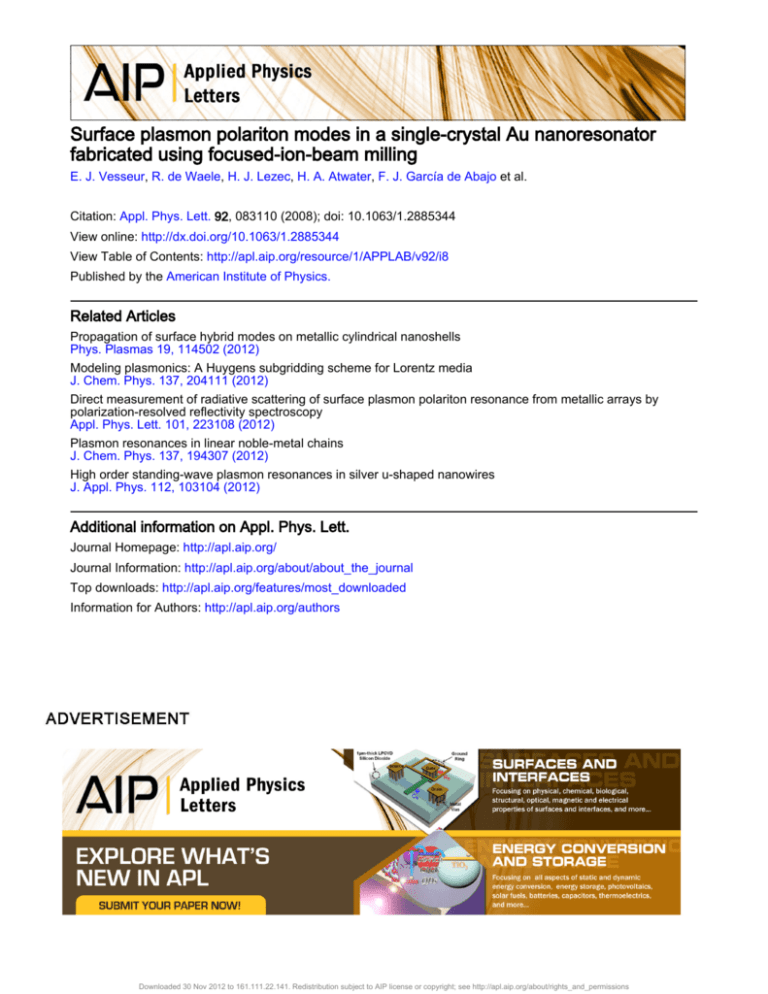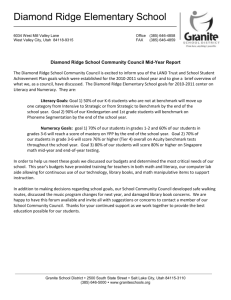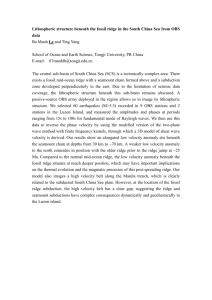Surface plasmon polariton modes in a single
advertisement

Surface plasmon polariton modes in a single-crystal Au nanoresonator fabricated using focused-ion-beam milling E. J. Vesseur, R. de Waele, H. J. Lezec, H. A. Atwater, F. J. García de Abajo et al. Citation: Appl. Phys. Lett. 92, 083110 (2008); doi: 10.1063/1.2885344 View online: http://dx.doi.org/10.1063/1.2885344 View Table of Contents: http://apl.aip.org/resource/1/APPLAB/v92/i8 Published by the American Institute of Physics. Related Articles Propagation of surface hybrid modes on metallic cylindrical nanoshells Phys. Plasmas 19, 114502 (2012) Modeling plasmonics: A Huygens subgridding scheme for Lorentz media J. Chem. Phys. 137, 204111 (2012) Direct measurement of radiative scattering of surface plasmon polariton resonance from metallic arrays by polarization-resolved reflectivity spectroscopy Appl. Phys. Lett. 101, 223108 (2012) Plasmon resonances in linear noble-metal chains J. Chem. Phys. 137, 194307 (2012) High order standing-wave plasmon resonances in silver u-shaped nanowires J. Appl. Phys. 112, 103104 (2012) Additional information on Appl. Phys. Lett. Journal Homepage: http://apl.aip.org/ Journal Information: http://apl.aip.org/about/about_the_journal Top downloads: http://apl.aip.org/features/most_downloaded Information for Authors: http://apl.aip.org/authors Downloaded 30 Nov 2012 to 161.111.22.141. Redistribution subject to AIP license or copyright; see http://apl.aip.org/about/rights_and_permissions APPLIED PHYSICS LETTERS 92, 083110 共2008兲 Surface plasmon polariton modes in a single-crystal Au nanoresonator fabricated using focused-ion-beam milling E. J. R. Vesseur,1,a兲 R. de Waele,1 H. J. Lezec,2,b兲 H. A. Atwater,2 F. J. García de Abajo,3 and A. Polman1 1 Center for Nanophotonics, FOM Institute AMOLF, Kruislaan 407, 1098 SJ Amsterdam, The Netherlands Department of Applied Physics, California Institute of Technology, Pasadena, California 91125, USA 3 Instituto de Óptica—CSIC, Serrano 121, 28006 Madrid, Spain 2 共Received 12 December 2007; accepted 4 February 2008; published online 28 February 2008兲 We use focused-ion-beam milling of a single-crystal Au surface to fabricate a 590-nm-long linear ridge that acts as a surface plasmon nanoresonator. Cathodoluminescence imaging spectroscopy is then used to excite and image surface plasmons on the ridge. Principal component analysis reveals distinct plasmonic modes, which proves confinement of surface plasmon oscillations to the ridge. Boundary-element-method calculations confirm that a linear ridge is able to support highly localized surface plasmon modes 共mode diameter ⬍100 nm兲. The results demonstrate that focused-ion-beam milling can be used in rapid prototyping of nanoscale single-crystal plasmonic components. © 2008 American Institute of Physics. 关DOI: 10.1063/1.2885344兴 Surface plasmon polaritons 共SPPs兲 are electromagnetic waves confined to a metal-dielectric interface. As shown in recent experiments, SPPs can be manipulated using waveguides1,2 and resonators.3,4 Surface plasmon polaritons hold promise for application in sensing, photovoltaics, telecommunications, and optoelectronic circuit integration due to their ability to concentrate and guide electromagnetic energy at the nanoscale. Fabrication of components that guide and confine SPPs involves structuring of metals, typically using methods such as electron beam lithography, nanoimprint lithography, selfassembly, or templating techniques. These methods offer high spatial resolution, but require complex multistep processing. Moreover, the metal films, most often obtained by thermal evaporation, typically have a polycrystalline structure. Grain boundaries and surface roughness in polycrystalline films are known to cause undesired scattering of SPPs. A single-step method to structure metals for plasmonic applications, that is gaining widespread acceptance, is focused-ion-beam 共FIB兲 milling.5,6 In a typical FIB system, Ga+ ions are extracted from a liquid-metal ion source, accelerated to 30 keV, and focused by an electrostatic lens system to a spot size with diameter as small as 5 – 10 nm. In this letter, we show how FIB milling of a singlecrystal Au substrate can be used for highly reproducible, maskless fabrication of a smooth plasmonic resonator, with minimum lateral dimension of 50 nm, and surface roughness on the scale of only a few nanometers. We use cathodoluminescence 共CL兲 imaging spectroscopy to generate SPPs 共Refs. 7 and 8兲 and image resonant modes within the metal nanostructures. The data demonstrate that FIB is an ideal tool for fabrication of nanoscale plasmonic components, in particular, when single-crystal metal substrates are employed. Our conclusions are supported by boundary-element-method 共BEM兲 calculations of the local fields at the metal nanostructures.9,10 a兲 Electronic mail: vesseur@amolf.nl. Present address: Center for Nanoscale Science and Technology, NIST, Gaithersburg, MD, USA. b兲 0003-6951/2008/92共8兲/083110/3/$23.00 Nanoplasmonic device fabrication consisted of focusedion-beam milling a polished 具111典 single-crystal Au substrate, grown using the Czochralski process. A 10 pA, 30 keV Ga beam from a FEI Nova 600 dual-beam workstation was rastered in 40 passes over a 4 ⫻ 5 m2 area, using a 1000⫻ 1250 pixel grid using a variable dwell time per pixel. Subtractive milling left behind a linear ridge, approximately 590 nm long, 95 nm high, and 80 nm wide. Fabrication of such a ridge takes roughly 1 min and is very reproducible. Resulting ridge roughness is on the order of a few nanometer. Figure 1 shows scanning electron microscope 共SEM兲 images of the ridge, taken at large azimuthal angle with respect to the normal. Views of the structure at two different polar angles are presented, respectively, several degrees off 共a兲 and along 共b兲 the ridge axis. The images reveal rounded features at the top of the ridge and at the base. We attribute this rounding to redeposition of Au during milling as well as the finite diameter of the ion beam 共⬃10 nm兲. The features visible in the milled area around the ridge are attributed to FIG. 1. 共Color online兲 共a兲 Scanning electron micrograph of a 590-nm-long linear ridge fabricated in a single-crystal Au substrate using focused-ionbeam milling. The ridge is approximately 95 nm high and 80 nm wide. 共b兲 The same ridge from a different angle. 共c兲 Boundary-element-method calculation of the field intensity 兩E兩2 near an infinitely long bell-shaped Au ridge. This calculation, performed at a photon energy 2.13 eV and k储 = 1.14 / c, shows that propagating surface plasmons at this energy are well confined to the top of the ridge and do not couple to the planar-surface plasmons, for which k储 = 1.07 / c. 92, 083110-1 © 2008 American Institute of Physics Downloaded 30 Nov 2012 to 161.111.22.141. Redistribution subject to AIP license or copyright; see http://apl.aip.org/about/rights_and_permissions 083110-2 Vesseur et al. Appl. Phys. Lett. 92, 083110 共2008兲 FIG. 3. 共Color online兲 Line profiles obtained by a fit of the data in Fig. 2共b兲 using the modeling factor-analysis method of Fig. 2. Each consecutive profile is shifted by one intensity unit for clarity. Numbers labeling each profile correspond to respective spectra of Fig. 2共d兲. Profiles 3 and 4 show resonant modes of the ridge with one and two antinodes on the ridge, respectively. FIG. 2. 共Color online兲 共a兲 Light emission from the ridge at 585 nm wavelength upon irradiation with a 30 kV electron beam, as function of electron beam position. 共b兲 Cathodoluminescence emission from a single-crystal Au ridge as function of electron beam position and wavelength, measured along the major axis of the ridge 关see dashed line in 共a兲兴. The ridge position is indicated by the bar to the right of the plot. A broad spectrum is emitted when the electron beam dwells on the ridge ends, while the signal from the ridge center is more sharply wavelength dependent. 共c兲 Reconstruction of the data from a fit using a modeling factor-analysis method with a Lorentzian shape imposed on five independent spectra, labeled 1–5 and plotted in 共d兲. The calculated data set in 共c兲 closely matches the experimental data in 共b兲. roughness that was initially present on the substrate, and enhanced under ion milling. We have investigated the crystalline structure of the ridge by scanning ion microscopy, employing focused ion beam imaging from secondary electrons. The absence of contrast within the ridge excludes that a polycrystalline structure was formed. CL measurements were done using a FEI XL30 SEM equipped with a parabolic mirror that collects 共with a solid angle of 1.4 sr兲 light generated when the electron beam impinges on the sample. The mirror directs the CL emission into a spectrometer that is equipped with a charge coupled device array detector. Spectral data are corrected for system response. The electron beam is scanned across the sample and for every position of the electron beam a spectrum is collected. Figure 2共a兲 shows a CL image of the ridge acquired at a center wavelength of 585 nm and a spectral bandwidth of 10 nm. The emission from the ridge is strongly dependent on position: clear maxima are observed at the ends and center of the ridge. Figure 2共b兲 shows spectral line traces 共wavelength range of 350– 850 nm兲, along the major axis of the ridge 关see dashed line in Fig. 2共a兲兴 obtained by integration over 3 pixels 共total distance of 21 nm兲 in the lateral direction of the ridge; the ridge position is indicated at the right-hand side of the figure. The data clearly show that a broad spectrum is emitted when the electron beam dwells on the ends of the ridge, while the emission from the center of the ridge is more sharply wavelength dependent. As we will show next, these features are related to resonant geometrical modes of the linear ridge nanoresonator. As previously shown,11–14 spatial CL images are a direct probe of resonant modes of plasmonic nanostructures. The measured CL spectrum at any position is assumed to be a linear superposition of multiple principal-mode spectra. We extract the principal modes from the data in Fig. 2共b兲 using a factor analysis method,15,16 that involves solving an eigenvalue problem: a two-dimensional data matrix D共x,兲 is defined, with one spectral and one spatial dimensions, corresponding to the dimensions of Fig. 2共b兲, respectively, as a product of two matrices D共x,兲 = R共x,n兲C共n,兲, one having n spatial profiles as columns and the other having the corresponding n spectra as rows. We find that five principal components, found using a “scree plot” of the logarithms of the eigenvalues versus component number, form a good representation of the data, so that matrices R and C with n = 5 can be used to construct the full data set. We then impose on the mode spectra a Lorentzian shape, parametrized by a peak wavelength and a characteristic width for every spectrum; an initial matrix C is composed of five spectra. The profile matrix R can then be computed by the pseudoinverse16 of C: R = DC+, for which a data set D̂ = RC is then calculated. The parameters for the spectra matrix C are then optimized using a least-squares method by minimizing the difference between the original data set D and the generated D̂. Figure 2共c兲 shows the obtained D̂. The result is in excellent agreement with the data, reproducing the spectral shape and intensity at all positions on the ridge. The resulting five spectra from C are plotted in Fig. 2共d兲. The peak wavelengths in Fig. 2共d兲 range from 425– 797 nm. The cavity Q factor, obtained from the width of spectrum 3 is Q = 5.3. Figure 3 displays the spatial profiles of the five spectra along the ridge, as given by R. Spatial profiles for spectra 3 and 4 are characteristic of resonant modes, with one and two antinodes on the ridge, respectively. The spatial profiles for spectra 1 and 2, at longer wavelengths, show antinodes on the ridge ends. The spatial profile for spectrum 5 shows a relatively constant intensity along the ridge; it may be associated with a higher order mode of which the spatial profile cannot be resolved, or transition radiation17 that does not have spatial dependence. Note that spectra 2 and 3, which are close together spectrally, have very distinct spatial profiles. This analysis demonstrates the existence of geometrical plasmon modes along the single-crystal Au ridge that are preferentially excited at antinodes in the modal electric field intensity. A BEM was used to calculate plasmon modes of a geometry similar to that of the experimental structure. Starting from a shape profile as input, the electric field is expressed in terms of charge and current distribution on the Downloaded 30 Nov 2012 to 161.111.22.141. Redistribution subject to AIP license or copyright; see http://apl.aip.org/about/rights_and_permissions 083110-3 Appl. Phys. Lett. 92, 083110 共2008兲 Vesseur et al. ridge, which are calculated self-consistently to fulfill the field boundary conditions. We choose a bell-shaped linear ridge of infinite length characterized by two different radii of curvature, as shown by the grey curve in Fig. 1共c兲. The shape is similar to that of the ridge imaged in Fig. 1共b兲. We first calculated the photonic local density of states 共LDOS兲 in the dielectric just above the top of the ridge 关indicated in Fig. 1共c兲 by the black cross兴. This was done for a range of energies, separating the LDOS into contributions arising from different spatial frequencies k储 along the ridge. For example, at an energy of 2.13 eV 关corresponding to a free space wavelength of 582 nm and peak 3 in Fig. 2共d兲兴, we find a LDOS maximum for k储 = 1.14 / c. This is significantly larger than the corresponding value k储 = 1.07 / c calculated for SPPs on a planar Au surface 共using identical optical constants兲, consistent with strong mode confinement to the ridge. We investigate the lateral field distribution of the ridge mode by calculating the near field around the ridge excited with a dipole placed above the ridge 关also at the position of the cross in Fig. 1共c兲兴. By subtracting the dipole field, we calculate the induced field in the plane normal to the major axis. Figure 1共c兲 shows the calculated values of 兩E兩2 around the ridge. Indeed, the figure shows that the intensity is very much confined to the top of the ridge, with a typical lateral confinement in the x and y directions well below 100 nm. From the BEM calculation, the plasmon propagation length along an infinitely long ridge is 4 m 共Q = 43兲. This implies that the measured value Q = 5.3 is due to the combined effect of Ohmic losses 共possibly enhanced by the presence of implanted Ga from the FIB process兲 and radiation losses from the ridge ends. In summary, we have shown that using focused-ionbeam milling, a smooth linear ridge that supports surface plasmon resonances can be fabricated on a single-crystal Au substrate. Spatially resolved cathodoluminescence spectroscopy shows that surface plasmons generated on this ridge are well confined to the ridge and form distinct geometrical modes. The data are confirmed by BEM calculations of the plasmon field distribution on the ridge, which show that a propagating surface plasmon is confined to the top of the ridge, with a mode diameter ⬍100 nm. These results show that FIB milling of a single-crystal noble metal surface can be used in rapid prototyping of nanoscale surface plasmon components. This work is part of the research program “Microscopy and modification of nanostructures with focused electron and ion beams” 共MMN兲 of FOM, which is financially supported by NWO. The MMN program is cofinanced by FEI Company. This work is also funded by NANONED, a nanotechnology program of the Dutch Ministry of Economic Affairs. Work at Caltech is financially supported by the AFOSR under MURI Grant No. FA9550-04-1-0434. F.J.G.A. acknowledges funding from the EU 共STRP-016881-SPANS兲. 1 J. Krenn and J.-C. Weeber, Philos. Trans. R. Soc. London, Ser. A 362, 739 共2004兲. 2 W. L. Barnes, A. Dereux, and T. W. Ebbesen, Nature 共London兲 424, 824 共2003兲. 3 H. T. Miyazaki and Y. Kurokawa, Phys. Rev. Lett. 96, 097401 共2006兲. 4 H. Ditlbacher, A. Hohenau, D. Wagner, U. Kreibig, M. Rogers, F. Hofer, F. R. Aussenegg, and J. R. Krenn, Phys. Rev. Lett. 95, 257403 共2005兲. 5 H. J. Lezec, A. Degiron, E. Devaux, R. A. Linke, L. Martin-Moreno, F. J. Garcia-Vidal, and T. W. Ebbesen, Science 297, 820 共2002兲. 6 C. A. Volkert and A. M. Minor, MRS Bull. 32, 389 共2007兲. 7 R. H. Ritchie, Phys. Rev. 106, 874 共1957兲. 8 F. J. García de Abajo 共unpublished兲. 9 F. J. García de Abajo and A. Howie, Phys. Rev. Lett. 80, 5180 共1998兲. 10 F. J. García de Abajo, Phys. Rev. B 59, 3095 共1999兲. 11 N. Yamamoto, K. Araya, and F. J. García de Abajo, Phys. Rev. B 64, 205419 共2001兲. 12 N. Yamamoto, M. Nakano, and T. Suzuki, Surf. Interface Anal. 38, 1725 共2006兲. 13 E. J. R. Vesseur, R. de Waele, M. Kuttge, and A. Polman, Nano Lett. 7, 2843 共2007兲. 14 C. E. Hofmann, E. J. R. Vesseur, L. A. Sweatlock, H. J. Lezec, F. J. García de Abajo, A. Polman, and H. A. Atwater, Nano Lett. 7, 3612 共2007兲. 15 M. Bosman, M. Watanabe, D. Alexander, and V. Keast, Ultramicroscopy 106, 1024 共2006兲. 16 E. R. Malinowski, Factor Analysis in Chemistry 共Wiley, New York, 1991兲. 17 N. Yamamoto, H. Sugiyama, and A. Toda, Proc. R. Soc. London, Ser. A 452, 2279 共1996兲. Downloaded 30 Nov 2012 to 161.111.22.141. Redistribution subject to AIP license or copyright; see http://apl.aip.org/about/rights_and_permissions





